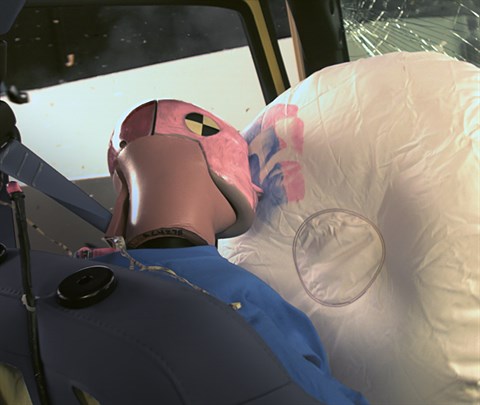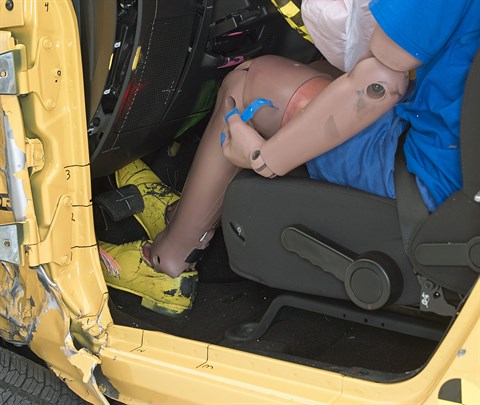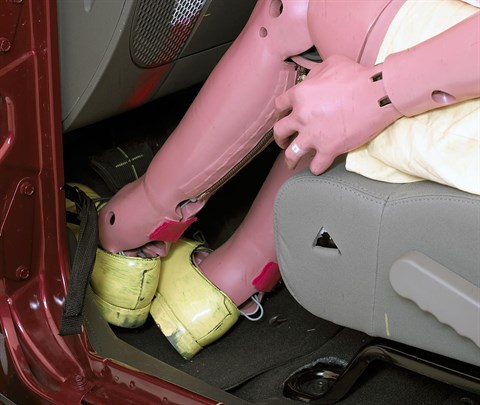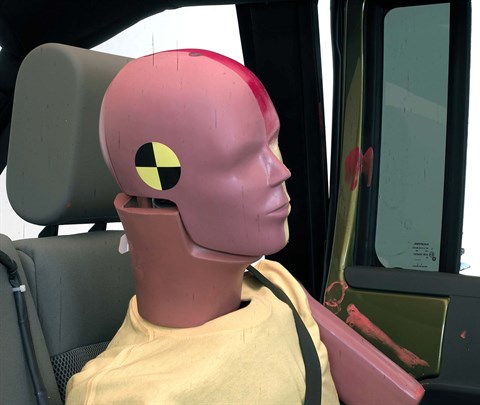Small overlap front: driver-side
Rating applies to 2007-17 models
Tested vehicle: 2015 Jeep Wrangler Unlimited Sport 4-door 4wd
The Jeep Wrangler was redesigned for the 2007 model year, and a larger, heavier 4-door model was added for the first time. For the 2018 model year only, the Wrangler was renamed the Wrangler JK, because the JK was built concurrently through much of the same model year as the redesigned 2018 Wrangler. These ratings apply only to the 2007-17 Wrangler and 2018 Wrangler JK.
| Evaluation criteria | Rating |
|---|---|
| Structure and safety cage | |
| Driver injury measures | |
| Head/neck | |
| Chest | |
| Hip/thigh | |
| Lower leg/foot | |
|
Driver restraints and dummy kinematics
The dummy’s movement was well controlled. The dummy’s head loaded the frontal airbag, which stayed in front of the dummy until rebound. However, the Wrangler is one of a handful of passenger vehicles still sold without standard side airbags to protect the head and chest from contact with side structure and outside objects. | |

Action shot taken during the small overlap frontal crash test.

The dummy's position in relation to the door frame, steering wheel, and instrument panel after the crash test indicates that the driver's survival space was maintained well.

The dummy’s movement was well controlled. The dummy’s head loaded the frontal airbag, which stayed in front of the dummy until rebound. However, the vehicle lacks standard side airbags to protect the head and chest from contact with side structure and outside objects.

Forces on the both the left and right lower legs were just high enough to indicate a moderate risk of injuries.
Moderate overlap front: original test
Rating applies to 2007-17 models
Tested vehicle: 2008 Jeep Wrangler Unlimited Sahara 4-door 4wd
The Jeep Wrangler was redesigned for the 2007 model year, and a larger, heavier 4-door model was added for the first time. For the 2018 model year only, the Wrangler was renamed the Wrangler JK, because the JK was built concurrently through much of the same model year as the redesigned 2018 Wrangler. These ratings apply only to the 2007-17 Wrangler and 2018 Wrangler JK.
| Evaluation criteria | Rating |
|---|---|
| Overall evaluation | |
| Structure and safety cage | |
| Driver injury measures | |
| Head/neck | |
| Chest | |
| Leg/foot, left | |
| Leg/foot, right | |
| Driver restraints and dummy kinematics | |

Action shot taken during the moderate overlap frontal crash test.

The dummy's position in relation to the steering wheel and instrument panel after the crash test indicates that the driver's survival space was maintained well.

Dummy movement was well controlled. During rebound, the dummy's head hit only the head restraint, as indicated by smeared greasepaint.

Forces on the lower right leg were just high enough to indicate the possibility of injury.
Side: original test
Rating applies to 2007-17 models
Tested vehicle: 2008 Jeep Wrangler Unlimited Sahara 4-door 4wd without optional side airbags
The Jeep Wrangler was redesigned for the 2007 model year, and a larger, heavier 4-door model was added for the first time. For the 2018 model year only, the Wrangler was renamed the Wrangler JK, because the JK was built concurrently through much of the same model year as the redesigned 2018 Wrangler. These ratings apply only to the 2007-17 Wrangler and 2018 Wrangler JK.
During the crash, the driver door opened. This opening didn't significantly affect dummy movement during the test but shouldn't happen because, in some crashes, it could allow partial or complete occupant ejection, especially if the occupant is unbelted. This door opening resulted in a structure rating downgrade from good to acceptable.
| Evaluation criteria | Rating |
|---|---|
| Overall evaluation | |
| Structure and safety cage | |
| Driver injury measures | |
| Head/neck | |
| Torso | |
| Pelvis/leg | |
|
Driver head protection
Although the intruding barrier did not hit the dummy's head in this test, the head was not protected from contacts outside the vehicle. This indicates that only slightly different crash circumstances could produce a direct hit to a person's head. | |
| Rear passenger injury measures | |
| Head/neck | |
| Torso | |
| Pelvis/leg | |
|
Rear passenger head protection
The dummy's head was hit primarily by the window frame of the rear passenger door. This impact did not produce high head injury measures, but the head protection is inadequate. | |

View of the vehicle and barrier just after the crash test.

View of the vehicle after the crash showing the open driver door after the barrier was moved away.

Action shot taken during the side impact crash test showing the driver dummy's head leaning well outward and approaching the window sill. The broken glass is from the window of the driver door.

Smeared red greasepaint shows where the rear passenger dummy's head was hit by the rear door window frame.
Headlights
Ratings are given for 2 different headlight variations available on this vehicle.
Trim level(s)
- Sahara trim
- Rubicon trim
- 75th Anniversary Edition trim
- Winter trim
- Rubicon Hard Rock trim
- Chief trim
- Smokey Mountain trim
- Sport trim equipped with LED Lighting Group package
- Rubicon Recon trim
| Evaluation criteria | Rating |
|---|---|
| Low-beam headlight type | LED reflector |
| High-beam headlight type | LED reflector |
| Curve-adaptive? | No |
| High-beam assist? | No |
|
Overall rating | |
| Distance at which headlights provide at least 5 lux illumination: | |
Low beams
On the straightaway, visibility was inadequate on both sides of the road. On curves, visibility was inadequate in all 4 tests.
The low beams never exceeded glare limits.
High beams
On the straightaway, visibility was good on the right side of the road and fair on the left side. On curves, visibility was inadequate in all 4 tests.
Trim level(s)
- Sport trim
- Sport S trim
- Willys Wheeler trim
- Freedom Edition trim
- Willys Wheeler W trim
- Big Bear trim
| Evaluation criteria | Rating |
|---|---|
| Low-beam headlight type | Halogen reflector |
| High-beam headlight type | Halogen reflector |
| Curve-adaptive? | No |
| High-beam assist? | No |
|
Overall rating | |
| Distance at which headlights provide at least 5 lux illumination: | |
Low beams
On the straightaway, visibility was fair on the left side of the road and inadequate on the right side. On curves, visibility was inadequate in all 4 tests.
The low beams created some glare.
High beams
On the straightaway, visibility was inadequate on both sides of the road. On curves, visibility was inadequate in all 4 tests.
Child seat anchors
Rating applies to 2015-17 models
| Evaluation criteria | Rating |
|---|---|
| Overall evaluation | |
| Vehicle trim | Unlimited Sport |
| Seat type | cloth |
This vehicle has 2 rear seating positions with complete child seat attachment (LATCH) hardware.
It has 1 additional seating position with a tether anchor and the ability to borrow lower anchors from the other seating positions.
Note: When anchors are borrowed, they aren't available to use in their designated positions.
| Evaluation criteria | Rating |
|---|---|
| Overall evaluation | |
| Vehicle trim | Unlimited Sport |
| Seat type | cloth |
| Rating icon | Rating |
|---|---|
| G | Good |
| A | Acceptable |
| M | Marginal |
| P | Poor |
| Seating positions that rely on borrowed lower anchors or have only a tether anchor available are not rated. | |
thether anchor symbol | Tether anchor |
lower anchor symbol | Lower anchors |
| Lower anchor(s) can be borrowed from adjacent positions(s) | |
| No hardware available |
Details by seating position
| Position | Rating |
|---|---|
| 1 | |
| Tether anchor | |
| hard-to-find location | |
| other hardware could be confused for anchor | |
| Lower anchors | |
| not too deep in seat | |
| not too much force needed to attach | |
| easy to maneuver around anchors | |
| 2 | |
| Tether anchor | |
| hard-to-find location | |
| no other hardware could be confused for anchor | |
| Lower anchors | |
| Can be borrowed from 1 and 3 | |
| 3 | |
| Tether anchor | |
| hard-to-find location | |
| other hardware could be confused for anchor | |
| Lower anchors | |
| not too deep in seat | |
| not too much force needed to attach | |
| difficult to maneuver around anchors |
